Chapter: Mechanical and Electrical : Thermal Engineering : Refrig Eration and Air Conditioning
Refrigeration and Air Conditioning
REFRIGERATION AND AIR CONDITIONING
PREREQUISITE DISCUSSION
Before 1830, few Am ericans used ice to refrigerate foods due to
a lack of ice-storehouses and iceboxes. As these two things became more widely
available, individuals used axes and saws to harvestt ice for their
storehouses. This method proved to be difficult, dangerous, and certainly did
not resemble anything that could be du plicated on a commercial scale.
Despite the difficulti es of harvesting ice, Frederic Tudor
thought that he could capitalize on this new commo dity by harvesting ice in
New England and shipping it to the Caribbean islands as well as the southern
states. In the beginning, Tudor lost thousands of dollars, but eventually
turned a profit as he constructed icehouses in Charle ston, Virginia and in the
Cuban port town of Havana. These icehouses as well as better insulated ships
helped reduce ice wastage from 66% to 8%. This efficiency gain influen ced
Tudor to expand his ice market to othe r towns with icehouses such as New
Orleans a nd Savannah.
This ice market further expan ded as
harvesting ice became faster and cheap er after one of Tudor’s suppliers, Nathaniel Wyeth, invented a horse-drawn ice cutter in 1825. This
invention as well as Tudor’s s uccess inspired others to get involved in the
ice trade and the ice industry grew.
Ice became a mass-m arket commodity
by the early 1830s with the price of ice dropping from six cents per pound to a
half of a cent per pound. In New York City, ice consumption
increased from 12,000 tons in 1843 to 100,000 tons in 1 856. Boston’s consumption leapt from 6,00 0 tons to 85,000 tons during that
same period. Ice harvesting created a “cooling
culture” as majority of people used ice and iceboxes to
store their dairy products, fish, meat, and ev en fruits and vegetables. These
early cold storage practices paved the way for many Ame ricans to accept the
refrigeration technology that would soon take over the country.
CONCEPT
CONCEPT OF
REFRIGERATION
Refrigeration
is
a pro cess in which work is done to move heat from one location to another.
The work of heat trannsport is traditionally driven by mechanical work, but can
also be driven by heat, magnetism , electricity, laser, or other means.
How does
it work?

Thermal energy moves from left to right through
five loops of heat trans fer:
1) Indoor
air loop
2) Chilled
water loop
3) Refrigerant
loop
4) Condenser
water loop
5) Cooling
water loop

SIGNIFICANCE
Refrigeration has had a large importance on industry, lifestyle,
a griculture and settlement patterns. The idea of preserving food dates back to
the ancien t Roman and Chinese empires. However, refrigeration technology has
rapidly evolved in the last century, from ice harvesting to
temperature-controlled rail cars. In order to avoid food spoilage,
refrigeration plays an important role in day to day life, similarly, Air
conditioning is also an important technological system to prevent the human
from the hot atmosphere during summer seasons.
CLASSIFICATION OF
REFRIGERATION SYSTEM
Types of Refrigeratio n
•
Vapour Compression Refrigeration (VCR): uses
mechanical energy
•
Vapour Absorption Re frigeration (VAR): uses
thermal energy
Vapour Compression
Refrigeration
•
Highly compressed flu ids tend to get colder when
allowed to expand
•
If pressure high enough
•
Compressed air hotter than source of cooling
•
Expanded gas cooler than desired cold temperature
• Lot of
heat can be rem oved (lot of thermal energy to change liquid to vapour)
• Heat
transfer rate re mains high (temperature of working fluid mu ch lower than
what is
being cooled)
Vapour
Compression Refrig eration Cycle

Evaporator
Low
pressure liquid re frigerant in evaporator absorbs heat and changes to a gas
Compressor
The
superheated vapo ur enters the compressor where its pressure is raised
Condenser
The
high pressure sup erheated gas is cooled in several stages in the co ndenser
Expansion
Liquid
passes through expansion device, which reduces its pressure an d controls the
flow into the evaporator
Type of refrigerant
•
Refrigerant determine d by the required cooling
temperature
•
Chlorinated fluorocarb ons (CFCs) or freons: R-11,
R-12, R-21, R-22 and R-502
Choice of compressor, design of condenser,
evaporator determined by
•
Refrigerant
•
Required cooling
•
Load
•
Ease of maintenance
•
Physical space requirements
•
Availability of utilities (water, power)
Vapour Absorption Refrigeration
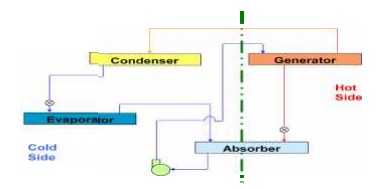
Evaporator

Absorber
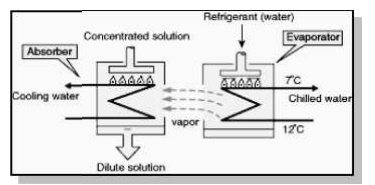
High pressure generator

Condenser

Evaporative Cooling
•
Air in contact with water to cool it
close to ‘wet bulb temperature’
•
Advantage: efficient cooling at low cost
•
Disadvantage: air is ri ch in moisture
COMPARISON
BETWEEN VAPOR COMPRESSION AND A BSORPTION SYSTEM

PERFORMANCE
Assessment of Refrigeration
•
Cooling effect: Tons of Refrigeration
1 TR = 3024
kCal /hr heat rejected
•
TR is assessed as:
TR
= Q x×Cp x× ( Ti – To) /
3024
Q = mass flow rate of coolant in
kg/hr
Cp = is coolant specific heat in kCal
/kg °C
Ti = inlet, temperature of
coolant to evaporator (chiller) in 0°C To = outlet temperature of coolant from
evaporator (chiller) in 0°C
Specific Power Consumption (kW/TR)
•
Indicator of refrigeration system’s
performance
•
kW/TR of centralized chilled water system is sum
of
•
Compressor kW/TR
•
Chilled water pump kW/TR
•
Condenser water pump kW/TR
•
Cooling tower fan kW/TR
Coefficient of Performance (COP)
•
The
performance of refrigerators
and heat pumps
is expressed in
terms of
coefficient of performance (COP), defined as
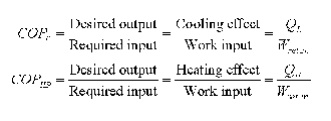
Measure
•
Airflow Q (m3/s) at Fan Coil Units (FCU) or Air
Handling Units (AHU): anemometer
•
Air density r(kg/m3)
•
Dry bulb and wet bulb temperature: psychrometer
•
Enthalpy (kCal/kg) of inlet air (hin) and
outlet air (Hout): psychrometric charts
APPLICATIONS OF
REFRIGERATRION
Ø Metal
workers
Ø Oil
refineries
Ø Chemical
plants
Ø Petrochemical
plants
Ø Transporting temperature-sensitive foodstuffs
Ø Dairy products
AIR CONDITIONERS
CONCEPT OF AIR CONDITIONING
Air
conditioning (often referred to as aircon, AC or A/C) is the process of
altering the properties of air (primarily temperatureand humidity) to more
favourable conditions, typically with the aim of distributing the conditioned
air to an occupied space to improve thermal comfort and indoor air quality.
TYPES OF AIR CONDITIONERS
•
Room air conditioners
•
Zoned Systems
•
Unitary Systems
•
Window Air-conditioning System
•
Split Air-conditioning System
•
Central air conditioning systems
1 ROOM AIR CONDITIONER
•
Room air conditioners cool rooms rather than the
entire home.
•
Less expensive to operate than central units
•
Their efficiency is generally lower than that of
central air conditioners.
•
Can be plugged into any 15- or 20-amp, 115-volt
household circuit that is not shared with any other major appliances
2 ZONED SYSTEMS
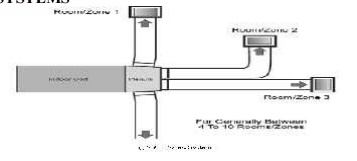
3 CENTRAL AIR CONDITIONING
•
Circulate cool air through a system of supply and
return ducts. Supply ducts and registers (i.e., openings in the walls, floors,
or ceilings covered by grills) carry cooled air from the air conditioner to the
home.
•
This cooled air becomes warmer as it circulates
through the home; then it flows back to the central air conditioner through
return ducts and registers

4.UNITARY
SYSTEMS
A unitary
air conditioning system comprises an outdoor unit including a compressor for
compressing a refrigerant, an outdoor heat exchanger for heat exchange of the
refrigerant and an expander connected to the outdoor heat exchanger, for
expanding the refrigerant; a duct installed inside a zone of a building; a
central blower unit having a heat exchanger connected to the outdoor unit
through a first refrigerant pipe and a blower for supplying the air
heat-exchanged by the heat exchanger to the duct; and an individual blower unit
including a heat exchanger connected to the outdoor unit through a second
refrigerant pipe and a fan for sending the air heat exchanged by the heat
exchanger and disposed in a zone in the building, for individually cooling or
heating the zone. Accordingly, cooling or heating operation is performed on
each zone of the building, and simultaneously, additional individual heating or
cooling operation can be performed on a specific space, so that a cost can be
reduced and cooling or heating in the building can be efficiently performed.
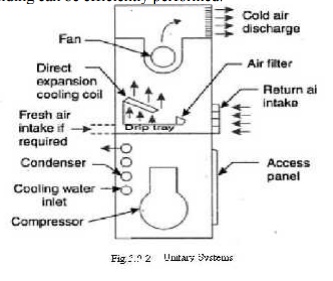
5.WINDOW AIR-CONDITIONING
SYSTEM
It is the
most commonly used air conditioner for single rooms. In this air conditioner
all the components, namely the compressor, condenser, expansion valve or coil,
evaporator and cooling coil are enclosed in a single box. This unit is fitted
in a slot made in the wall of the room, or often a window sill. Windows air
conditioners are one of the most widely used types of air conditioners because
they are the simplest form of the air conditioning systems. Window air
conditioner comprises of the rigid base on which all the parts of the window
air conditioner are assembled. The base is assembled inside the casing which is
fitted into the wall or the window of the room in which the air conditioner is
fitted. The whole assembly of the window air conditioner can be divided into
two compartments: the room side, which is also the cooling side and the outdoor
side from where the heat absorbed by the room air is liberated to the
atmosphere. The room side and outdoor side are separated from each other by an
insulated partition enclosed inside the window air conditioner assembly. In the
front of the window air conditioner on the room side there is beautifully
decorated front panel on which the supply and return air grills are fitted (the
whole front panel itself is commonly called as front grill). The louvers fitted
in the supply air grills are adjustable so as to supply the air in desired
direction. There is also one opening in the grill that allows access to the
Control panel or operating panel in front of the window air conditioner.
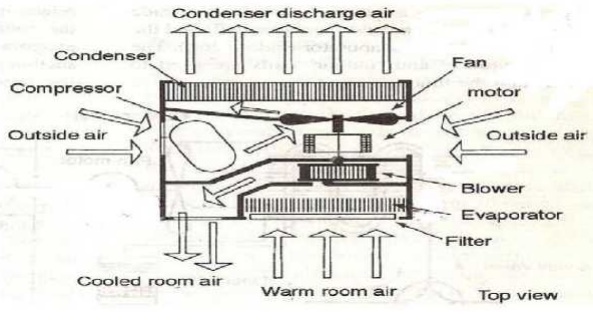
TYPES OF CENTRAL AC
•
split-system
•
An outdoor metal cabinet contains the condenser
and compressor, and an indoor cabinet contains the evaporator
•
Packaged
•
The evaporator, condenser, and compressor are all
located in one cabinet.
6 SPLIT AIR-CONDITIONING SYSTEM:
The split
air conditioner comprises of two parts: the outdoor unit and the indoor unit.
The outdoor unit, fitted outside the room, houses components like the
compressor, condenser and expansion valve. The indoor unit comprises the
evaporator or cooling coil and the cooling fan. For this unit you don't have to
make any slot in the wall of the room. Further, the present day split units
have aesthetic looks and add to the beauty of the room. The split air
conditioner can be used to cool one or two rooms.

Energy Consumption
•
Air conditioners are rated by the number of
British Thermal Units (Btu) of heat they can remove per hour. Another common
rating term for air conditioning size is the "ton," which is 12,000
Btu per hour.
•
Room air conditioners range from 5,500 Btu per
hour to 14,000 Btu per hour.
Energy Efficiency
•
Today's best air conditioners use 30% to 50% less
energy than 1970s
•
Even if your air conditioner is only 10 years old,
you may save 20% to 40% of your cooling energy costs by replacing it with a
newer, more efficient model
SOLVED PROBLEMS
1. A sling
psychrometer gives reading of 250c dry bulb temperature 1 50c
wet bulb temperature. The barome ter indicates 760 mm of hg assuming partial
pressure of the vapour as 10 mm of Hg. Determine 1. Specific humidity 2.
Saturation ratio.
Given
Data:
Dry
bulb temper ature td =250c
Wet bulb tempe rature tw=150c Barometer
pressure pb=760mm of Hg
Partial
pressure pv= 10mm of Hg
To
Find:
Specific
humidit y
Saturation
ratio.
Solution:
Specific
humidity:
We
know that Specific humidity

= 0.41
Result:
1. Specific
humidity 0.0083 kg/kg of dry air
2. Saturation
ratio . = 0.41
2. A two stages, single acting
air compressor compresses air to 20bar. The air enters the L.P cylinder at 1bar
a nd 27oc and leaves it at 4.7bar. the air en ters the H.P. cylinder
at 4.5bar and 27oc. the size of the L.P cylinder is 400mm diameter
and 5 00mm stroke. The clearance volume In both cylinder is 4% of the
respective stroke volume. The compressor runs at 200rpm, taking index of
compression and expansi on in the two cylinders as 1.3, estimate 1. The
indicated power required to run the co mpressor; and 2. The heat rejected in
the intercooler per minute.
Given data:
Pressure
(P4)= 20bar
Pressure
(P1) = 1 bar = 1× 105 N/m2
Temperature (T1 ) = 27oC = 27+273 =
300K Pressure (P 2) = 4.7bar
Pressure
(P3) = 4.5bar
Temperature (T3 ) = 27oC = 27+273 =
300K Diameter ( D1) = 400mm 0.4m Stroke (L1) = 500 mm = 0.5m
K = 0.04
N
= 200rpm ; n = 1.3
To Find:
Indicated
power required to run the compressor
Solution :
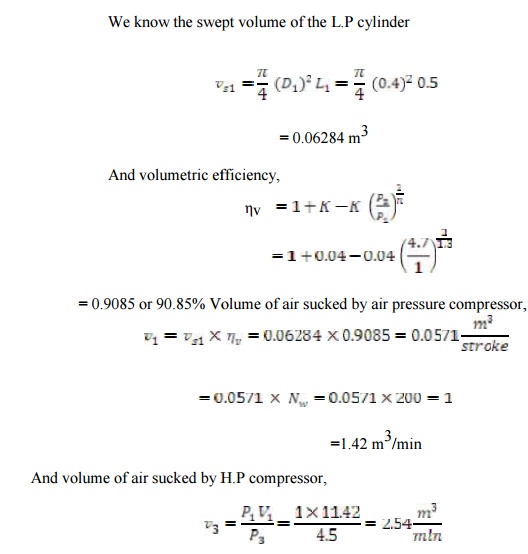

=
2 043.5× 103 J/min = 2034.5 KJ/min
Total
indicated work done by the compressor,
W
= WL + WH = 2123.3 + 2034.5
=
4157.8 KJ/min
Indicated
power required to run the compressor = 4157.8 / 60
=
69.3KW
3. In an oil gas turbine installation , air is
taken as 1 bar and 30oC . The air is compressed
to 4bar and then heated by b
urning the oil to a temperature of 500oC . If the air flows at the
rate of 90Kg/min . Find the power developed by the plant take γ for air
as 1.4 Cp as 1KJ/KgK . If 2.4Kg of oil having calorific value of 40,000 KJ/Kg
if b urned in the combustion chamber per min ute. Find the overall efficiency
of the plant.
Given
Data:
Pressure (P4 = P3) = 1bar Pressure (P1 = P2) =
4bar
Temperature
(T2) = 500oC = 500+273 = 773K
Mass flow rate of air(ma) =
90Kg/min = 1.5Kg/sec Mass flow rate of fuel (mf) = 2.4Kg/min = 0.04Kg/sec
Temperature (T4) = 30oC = 30+273 = 303K
γ
= 1.4
; Cp = 1KJ/KgK ; Cv= 40,000 KJ/Kg
To
Find:
Power developed by
the plant
Performance of the
gas turbine
Overall
efficiency of the plant
Solution:

TECHNICAL
TERMS
BTU - British
thermal unit. A unit of heat energy - approximately the amount of energy needed to heat one pound of water by one degree
Fahrenheit.
dBA – a unit for measuring sound power or pressure,
deciBel on the A scale.
Capacity – the ability of a heating or cooling system to heat
or cool a given amount of space.
For heating, this is usually expressed
in BTU’s. For cooling, it is usually given in tons.
Compressor – the pump that moves the refrigerant from the
indoor evaporator to the outdoor condenser
and back to the evaporator again. The compressor is often called “the heart of
the system” because it circulates the refrigerant through the
loop.
Condenser – a device used to condense a refrigerant thereby
rejecting the heat to another source, typically
an air cooled or water cooled condenser.
Cassette – a fan coil unit that fits mainly in the ceiling
void with only a diffuser plate visible, diffuses
conditioned air in one, two, three or four directions.
HVAC – heating, ventilation and air conditioning.
Inverter
system – Constantly
alters fan and motor speeds. This enables faster cooling of a room, and the inverter air conditioner doesn’t
have to switch itself on and off to maintain a constant
temperature.
kw – standard measurement of heat or power, 1kw = 1000
watts = 3412Btu/hr = 860kcal.
Load
Calculation – a
mathematical design tool used to determine the heat gain and heat loss in a building so that properly sized air
conditioning and heating equipment may be installed.
Refrigerant – a substance that produces a refrigerating effect
while expanding or vaporizing.
Reverse
cycle – the
reverse cycle air conditioner internally reverses its operation to provide heating or cooling, as required.
Split System
– a central air conditioner consisting of two or
more major components. The system
usually consists of a compressor-containing unit and condenser, installed
outside the building and a non-compressor –
containing air handling unit installed within the building. This is the most
common type of system installed in a home.
Zoning – the practice of providing independent heating
and/or cooling to different areas in a structure.
Zoning typically utilizes a system controller, zoning dampers controlled by a
thermostat in each zone, and a bypass damper to regulate static pressure in the
supply duct.
Related Topics